Analysis of Wireless Networking Concepts, Technologies & Future
VerifiedAdded on 2023/06/14
|23
|1570
|118
Report
AI Summary
This report provides an overview of wireless networking concepts and technologies. It begins by defining spread spectrum and comparing direct sequence spread spectrum (DSSS) with frequency hopping spread spectrum (FHSS). The report then discusses the components of a radio system, including radio transmitters and receivers, and classifies mixers into analog, digital, and powered types, detailing their functionalities. Finally, the report touches upon the future of cellular antennas and GiFi technology in telecommunications, highlighting their potential impact on wireless networks. Desklib offers a wealth of resources for students, including solved assignments and past papers.
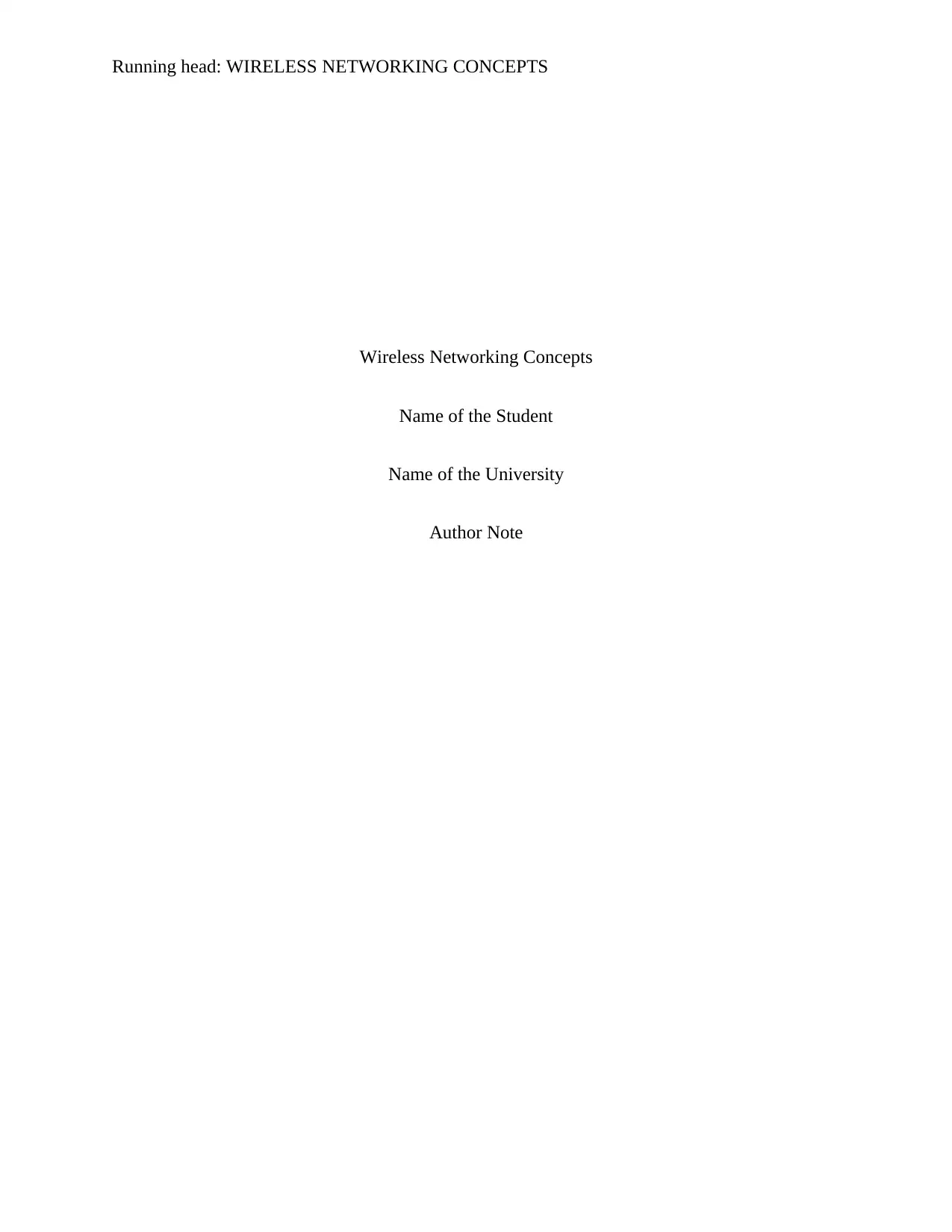
Running head: WIRELESS NETWORKING CONCEPTS
Wireless Networking Concepts
Name of the Student
Name of the University
Author Note
Wireless Networking Concepts
Name of the Student
Name of the University
Author Note
Paraphrase This Document
Need a fresh take? Get an instant paraphrase of this document with our AI Paraphraser
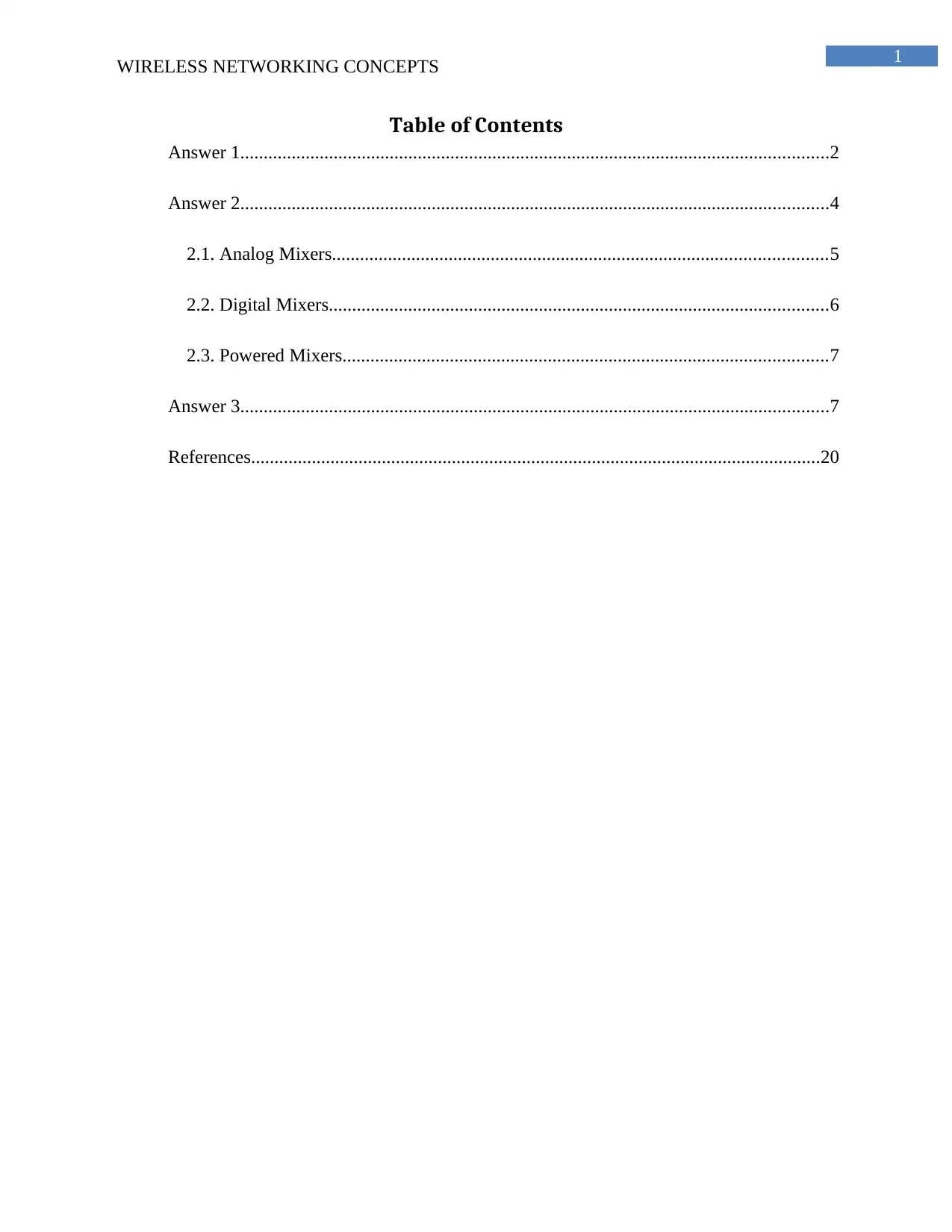
1
WIRELESS NETWORKING CONCEPTS
Table of Contents
Answer 1..............................................................................................................................2
Answer 2..............................................................................................................................4
2.1. Analog Mixers..........................................................................................................5
2.2. Digital Mixers...........................................................................................................6
2.3. Powered Mixers........................................................................................................7
Answer 3..............................................................................................................................7
References..........................................................................................................................20
WIRELESS NETWORKING CONCEPTS
Table of Contents
Answer 1..............................................................................................................................2
Answer 2..............................................................................................................................4
2.1. Analog Mixers..........................................................................................................5
2.2. Digital Mixers...........................................................................................................6
2.3. Powered Mixers........................................................................................................7
Answer 3..............................................................................................................................7
References..........................................................................................................................20
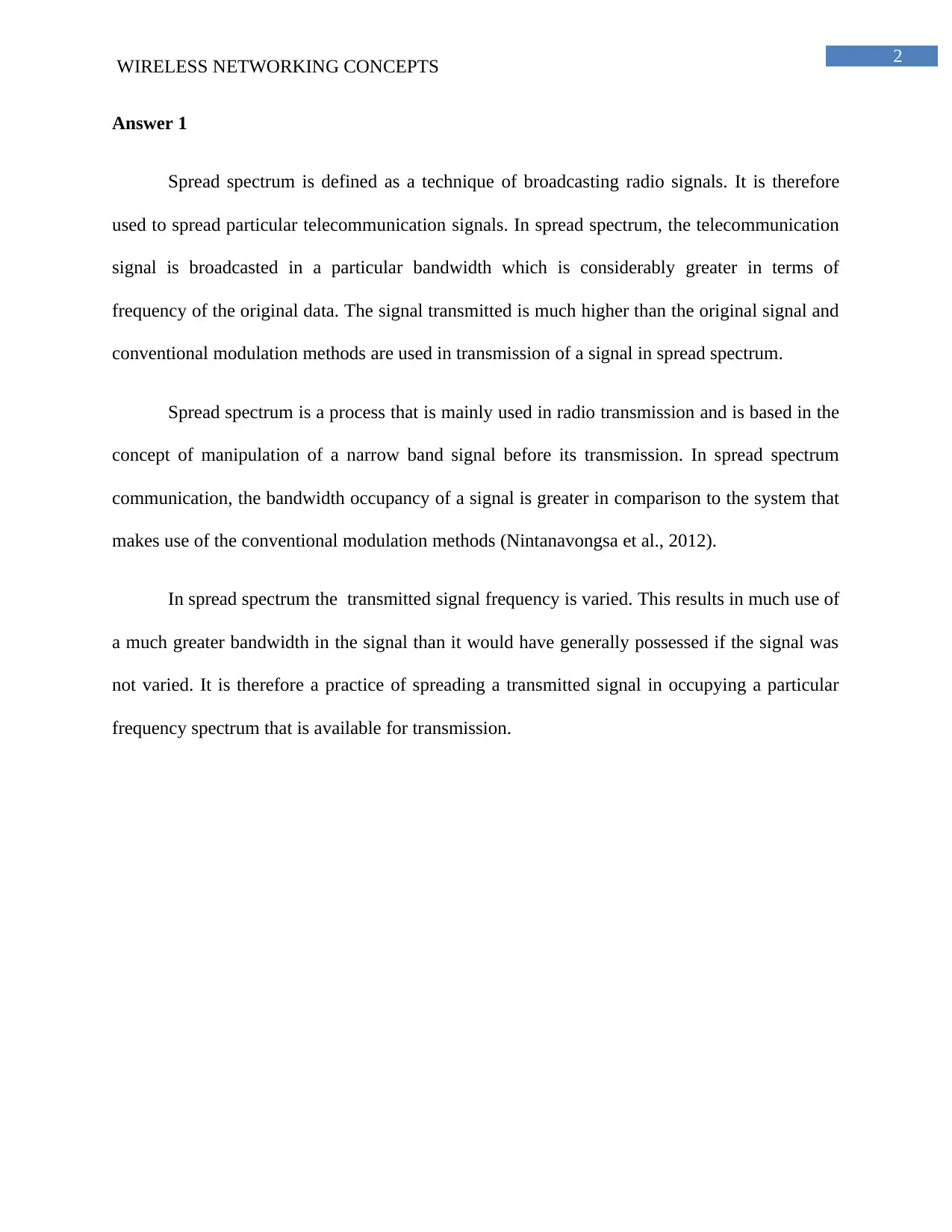
2
WIRELESS NETWORKING CONCEPTS
Answer 1
Spread spectrum is defined as a technique of broadcasting radio signals. It is therefore
used to spread particular telecommunication signals. In spread spectrum, the telecommunication
signal is broadcasted in a particular bandwidth which is considerably greater in terms of
frequency of the original data. The signal transmitted is much higher than the original signal and
conventional modulation methods are used in transmission of a signal in spread spectrum.
Spread spectrum is a process that is mainly used in radio transmission and is based in the
concept of manipulation of a narrow band signal before its transmission. In spread spectrum
communication, the bandwidth occupancy of a signal is greater in comparison to the system that
makes use of the conventional modulation methods (Nintanavongsa et al., 2012).
In spread spectrum the transmitted signal frequency is varied. This results in much use of
a much greater bandwidth in the signal than it would have generally possessed if the signal was
not varied. It is therefore a practice of spreading a transmitted signal in occupying a particular
frequency spectrum that is available for transmission.
WIRELESS NETWORKING CONCEPTS
Answer 1
Spread spectrum is defined as a technique of broadcasting radio signals. It is therefore
used to spread particular telecommunication signals. In spread spectrum, the telecommunication
signal is broadcasted in a particular bandwidth which is considerably greater in terms of
frequency of the original data. The signal transmitted is much higher than the original signal and
conventional modulation methods are used in transmission of a signal in spread spectrum.
Spread spectrum is a process that is mainly used in radio transmission and is based in the
concept of manipulation of a narrow band signal before its transmission. In spread spectrum
communication, the bandwidth occupancy of a signal is greater in comparison to the system that
makes use of the conventional modulation methods (Nintanavongsa et al., 2012).
In spread spectrum the transmitted signal frequency is varied. This results in much use of
a much greater bandwidth in the signal than it would have generally possessed if the signal was
not varied. It is therefore a practice of spreading a transmitted signal in occupying a particular
frequency spectrum that is available for transmission.
⊘ This is a preview!⊘
Do you want full access?
Subscribe today to unlock all pages.

Trusted by 1+ million students worldwide
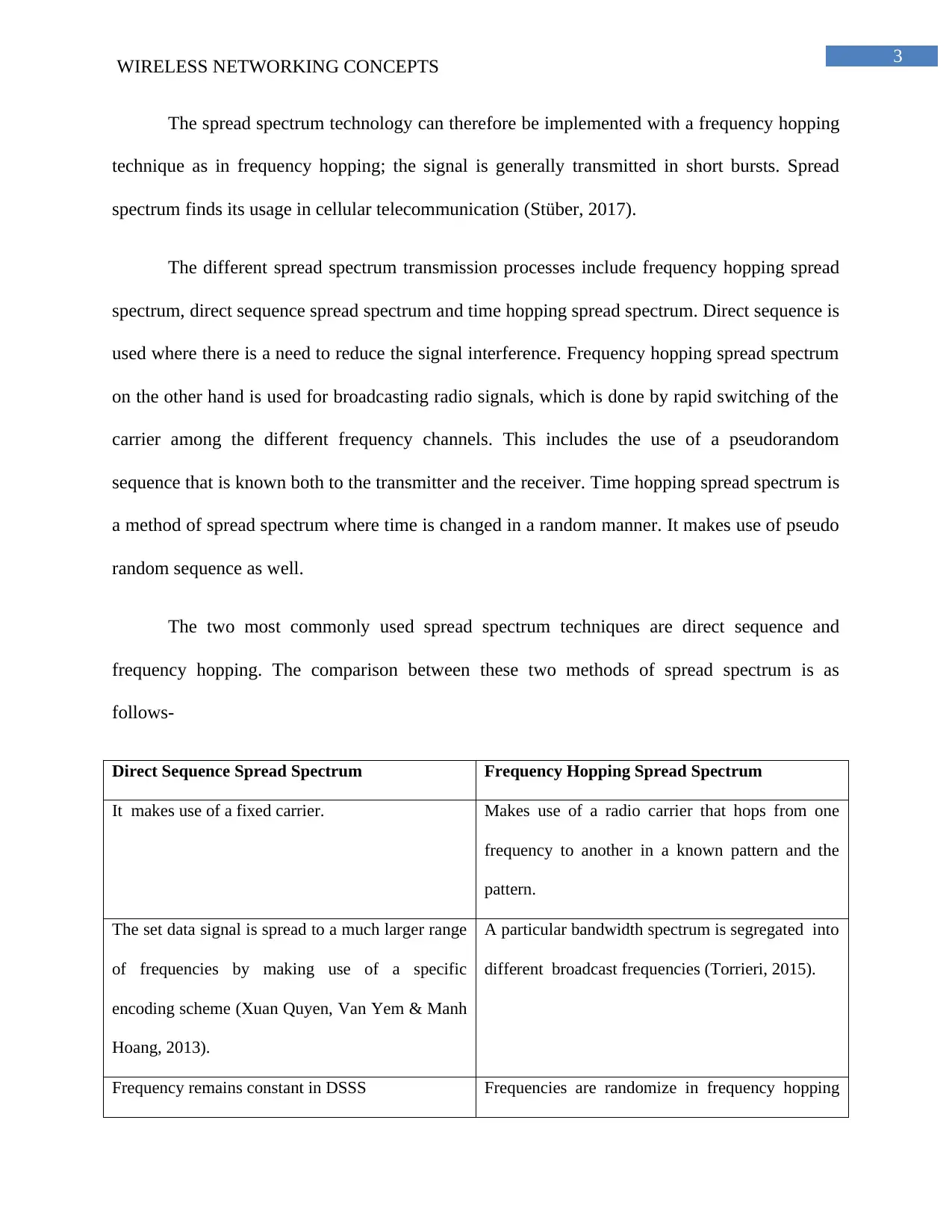
3
WIRELESS NETWORKING CONCEPTS
The spread spectrum technology can therefore be implemented with a frequency hopping
technique as in frequency hopping; the signal is generally transmitted in short bursts. Spread
spectrum finds its usage in cellular telecommunication (Stüber, 2017).
The different spread spectrum transmission processes include frequency hopping spread
spectrum, direct sequence spread spectrum and time hopping spread spectrum. Direct sequence is
used where there is a need to reduce the signal interference. Frequency hopping spread spectrum
on the other hand is used for broadcasting radio signals, which is done by rapid switching of the
carrier among the different frequency channels. This includes the use of a pseudorandom
sequence that is known both to the transmitter and the receiver. Time hopping spread spectrum is
a method of spread spectrum where time is changed in a random manner. It makes use of pseudo
random sequence as well.
The two most commonly used spread spectrum techniques are direct sequence and
frequency hopping. The comparison between these two methods of spread spectrum is as
follows-
Direct Sequence Spread Spectrum Frequency Hopping Spread Spectrum
It makes use of a fixed carrier. Makes use of a radio carrier that hops from one
frequency to another in a known pattern and the
pattern.
The set data signal is spread to a much larger range
of frequencies by making use of a specific
encoding scheme (Xuan Quyen, Van Yem & Manh
Hoang, 2013).
A particular bandwidth spectrum is segregated into
different broadcast frequencies (Torrieri, 2015).
Frequency remains constant in DSSS Frequencies are randomize in frequency hopping
WIRELESS NETWORKING CONCEPTS
The spread spectrum technology can therefore be implemented with a frequency hopping
technique as in frequency hopping; the signal is generally transmitted in short bursts. Spread
spectrum finds its usage in cellular telecommunication (Stüber, 2017).
The different spread spectrum transmission processes include frequency hopping spread
spectrum, direct sequence spread spectrum and time hopping spread spectrum. Direct sequence is
used where there is a need to reduce the signal interference. Frequency hopping spread spectrum
on the other hand is used for broadcasting radio signals, which is done by rapid switching of the
carrier among the different frequency channels. This includes the use of a pseudorandom
sequence that is known both to the transmitter and the receiver. Time hopping spread spectrum is
a method of spread spectrum where time is changed in a random manner. It makes use of pseudo
random sequence as well.
The two most commonly used spread spectrum techniques are direct sequence and
frequency hopping. The comparison between these two methods of spread spectrum is as
follows-
Direct Sequence Spread Spectrum Frequency Hopping Spread Spectrum
It makes use of a fixed carrier. Makes use of a radio carrier that hops from one
frequency to another in a known pattern and the
pattern.
The set data signal is spread to a much larger range
of frequencies by making use of a specific
encoding scheme (Xuan Quyen, Van Yem & Manh
Hoang, 2013).
A particular bandwidth spectrum is segregated into
different broadcast frequencies (Torrieri, 2015).
Frequency remains constant in DSSS Frequencies are randomize in frequency hopping
Paraphrase This Document
Need a fresh take? Get an instant paraphrase of this document with our AI Paraphraser
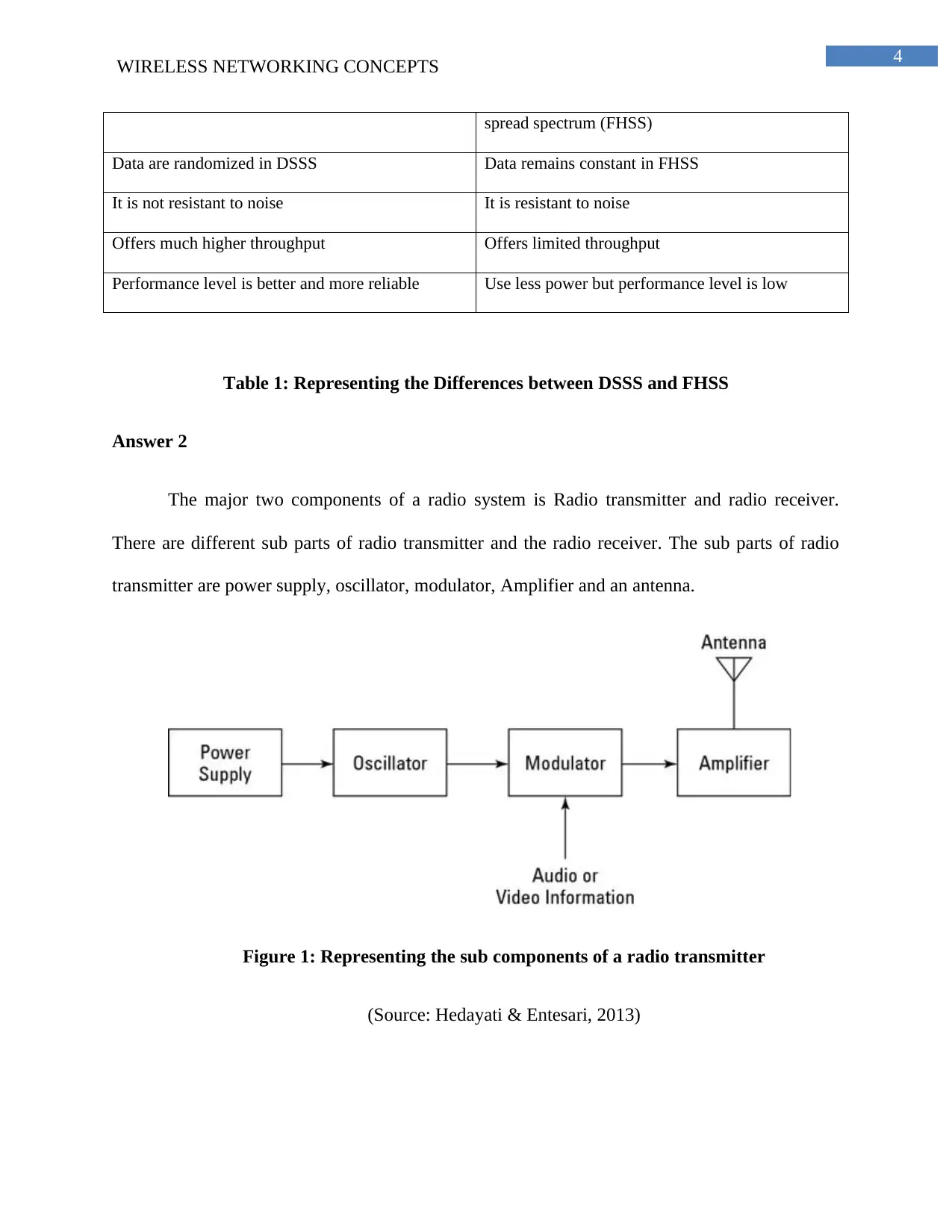
4
WIRELESS NETWORKING CONCEPTS
spread spectrum (FHSS)
Data are randomized in DSSS Data remains constant in FHSS
It is not resistant to noise It is resistant to noise
Offers much higher throughput Offers limited throughput
Performance level is better and more reliable Use less power but performance level is low
Table 1: Representing the Differences between DSSS and FHSS
Answer 2
The major two components of a radio system is Radio transmitter and radio receiver.
There are different sub parts of radio transmitter and the radio receiver. The sub parts of radio
transmitter are power supply, oscillator, modulator, Amplifier and an antenna.
Figure 1: Representing the sub components of a radio transmitter
(Source: Hedayati & Entesari, 2013)
WIRELESS NETWORKING CONCEPTS
spread spectrum (FHSS)
Data are randomized in DSSS Data remains constant in FHSS
It is not resistant to noise It is resistant to noise
Offers much higher throughput Offers limited throughput
Performance level is better and more reliable Use less power but performance level is low
Table 1: Representing the Differences between DSSS and FHSS
Answer 2
The major two components of a radio system is Radio transmitter and radio receiver.
There are different sub parts of radio transmitter and the radio receiver. The sub parts of radio
transmitter are power supply, oscillator, modulator, Amplifier and an antenna.
Figure 1: Representing the sub components of a radio transmitter
(Source: Hedayati & Entesari, 2013)
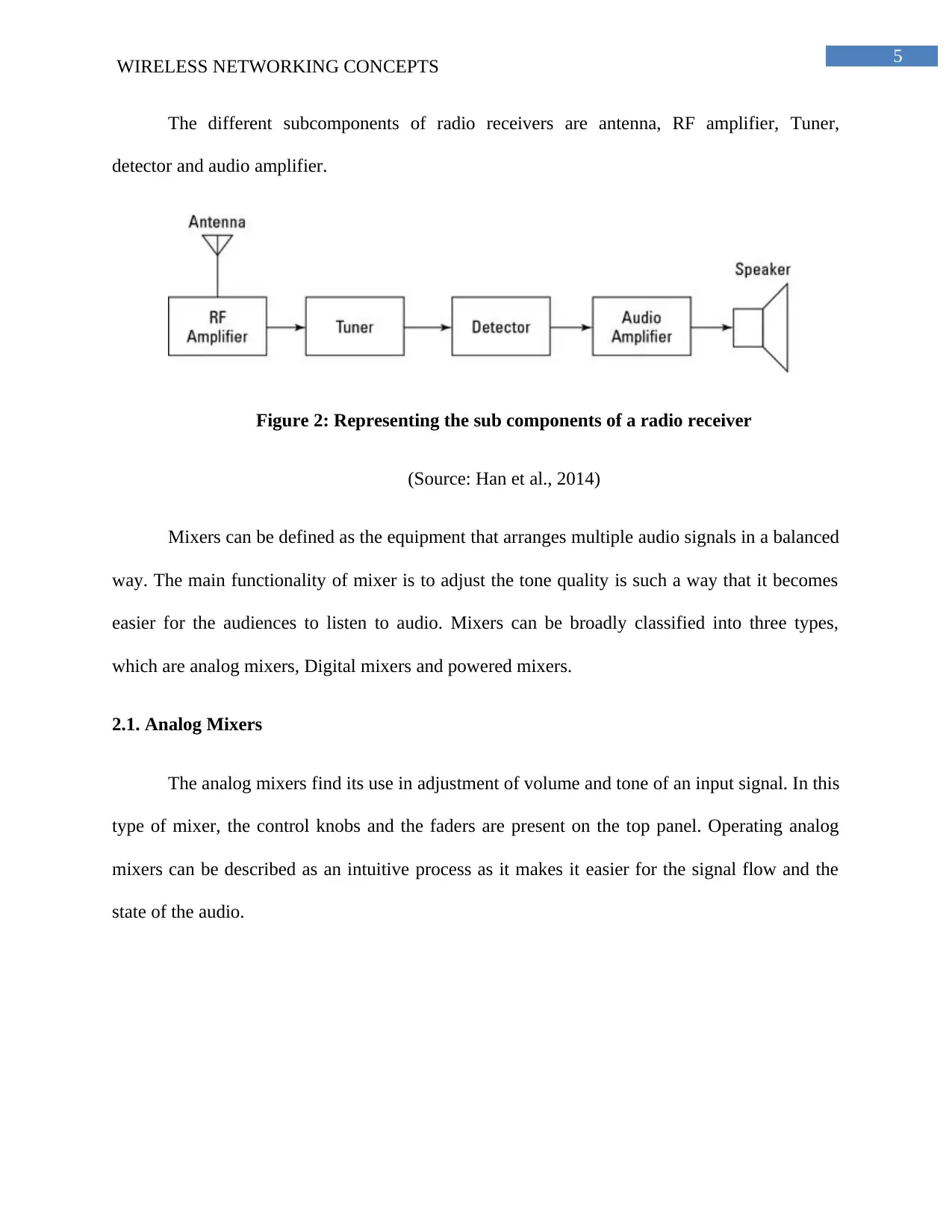
5
WIRELESS NETWORKING CONCEPTS
The different subcomponents of radio receivers are antenna, RF amplifier, Tuner,
detector and audio amplifier.
Figure 2: Representing the sub components of a radio receiver
(Source: Han et al., 2014)
Mixers can be defined as the equipment that arranges multiple audio signals in a balanced
way. The main functionality of mixer is to adjust the tone quality is such a way that it becomes
easier for the audiences to listen to audio. Mixers can be broadly classified into three types,
which are analog mixers, Digital mixers and powered mixers.
2.1. Analog Mixers
The analog mixers find its use in adjustment of volume and tone of an input signal. In this
type of mixer, the control knobs and the faders are present on the top panel. Operating analog
mixers can be described as an intuitive process as it makes it easier for the signal flow and the
state of the audio.
WIRELESS NETWORKING CONCEPTS
The different subcomponents of radio receivers are antenna, RF amplifier, Tuner,
detector and audio amplifier.
Figure 2: Representing the sub components of a radio receiver
(Source: Han et al., 2014)
Mixers can be defined as the equipment that arranges multiple audio signals in a balanced
way. The main functionality of mixer is to adjust the tone quality is such a way that it becomes
easier for the audiences to listen to audio. Mixers can be broadly classified into three types,
which are analog mixers, Digital mixers and powered mixers.
2.1. Analog Mixers
The analog mixers find its use in adjustment of volume and tone of an input signal. In this
type of mixer, the control knobs and the faders are present on the top panel. Operating analog
mixers can be described as an intuitive process as it makes it easier for the signal flow and the
state of the audio.
⊘ This is a preview!⊘
Do you want full access?
Subscribe today to unlock all pages.

Trusted by 1+ million students worldwide
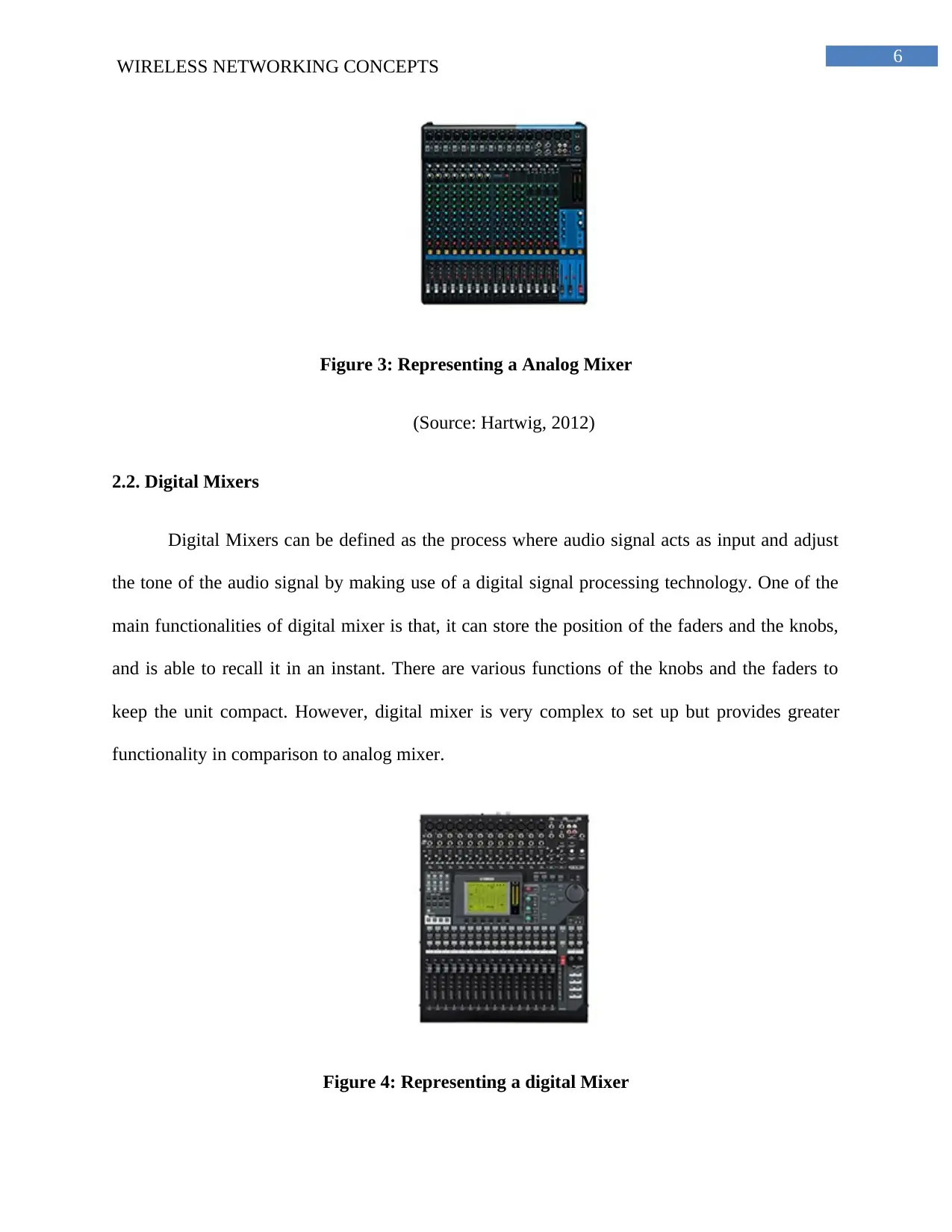
6
WIRELESS NETWORKING CONCEPTS
Figure 3: Representing a Analog Mixer
(Source: Hartwig, 2012)
2.2. Digital Mixers
Digital Mixers can be defined as the process where audio signal acts as input and adjust
the tone of the audio signal by making use of a digital signal processing technology. One of the
main functionalities of digital mixer is that, it can store the position of the faders and the knobs,
and is able to recall it in an instant. There are various functions of the knobs and the faders to
keep the unit compact. However, digital mixer is very complex to set up but provides greater
functionality in comparison to analog mixer.
Figure 4: Representing a digital Mixer
WIRELESS NETWORKING CONCEPTS
Figure 3: Representing a Analog Mixer
(Source: Hartwig, 2012)
2.2. Digital Mixers
Digital Mixers can be defined as the process where audio signal acts as input and adjust
the tone of the audio signal by making use of a digital signal processing technology. One of the
main functionalities of digital mixer is that, it can store the position of the faders and the knobs,
and is able to recall it in an instant. There are various functions of the knobs and the faders to
keep the unit compact. However, digital mixer is very complex to set up but provides greater
functionality in comparison to analog mixer.
Figure 4: Representing a digital Mixer
Paraphrase This Document
Need a fresh take? Get an instant paraphrase of this document with our AI Paraphraser
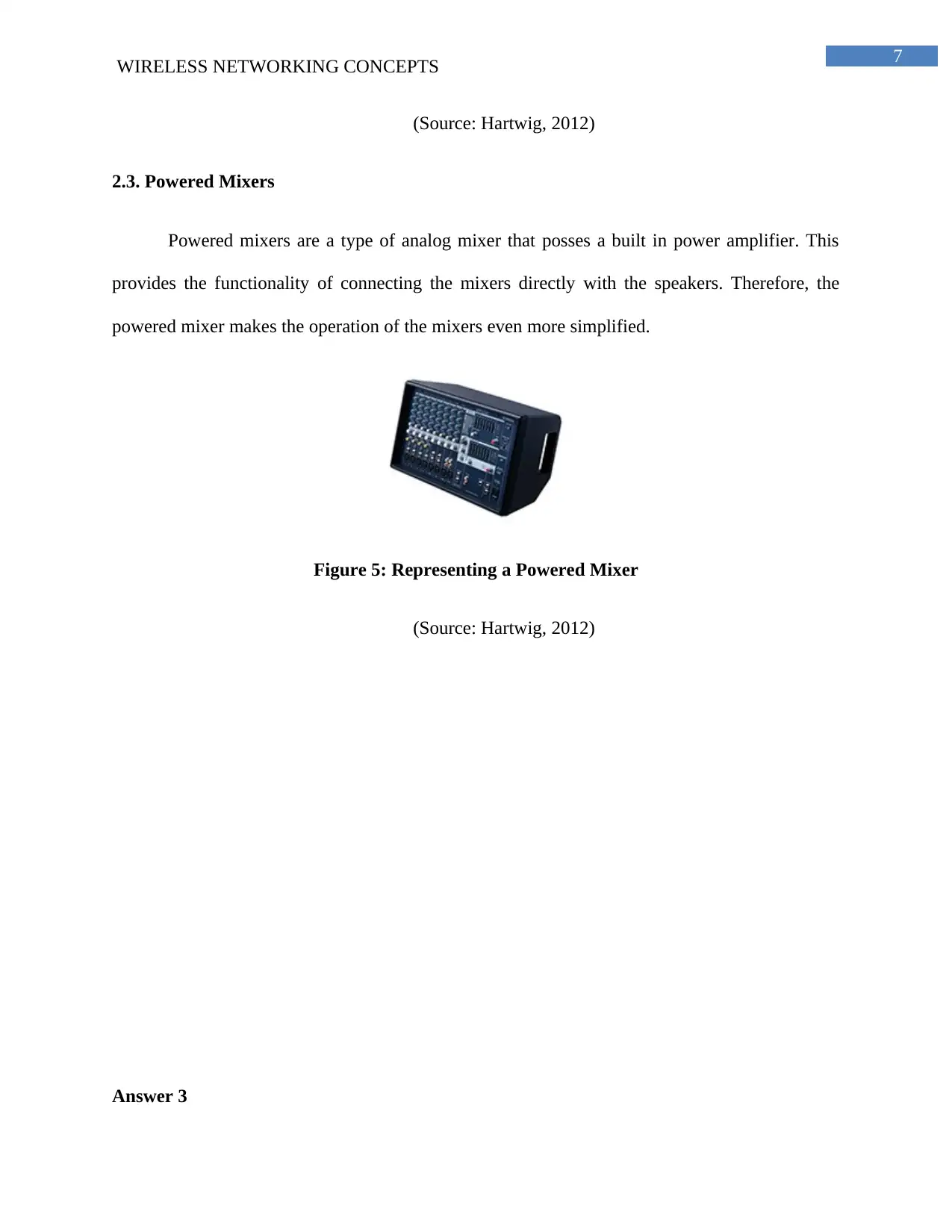
7
WIRELESS NETWORKING CONCEPTS
(Source: Hartwig, 2012)
2.3. Powered Mixers
Powered mixers are a type of analog mixer that posses a built in power amplifier. This
provides the functionality of connecting the mixers directly with the speakers. Therefore, the
powered mixer makes the operation of the mixers even more simplified.
Figure 5: Representing a Powered Mixer
(Source: Hartwig, 2012)
Answer 3
WIRELESS NETWORKING CONCEPTS
(Source: Hartwig, 2012)
2.3. Powered Mixers
Powered mixers are a type of analog mixer that posses a built in power amplifier. This
provides the functionality of connecting the mixers directly with the speakers. Therefore, the
powered mixer makes the operation of the mixers even more simplified.
Figure 5: Representing a Powered Mixer
(Source: Hartwig, 2012)
Answer 3
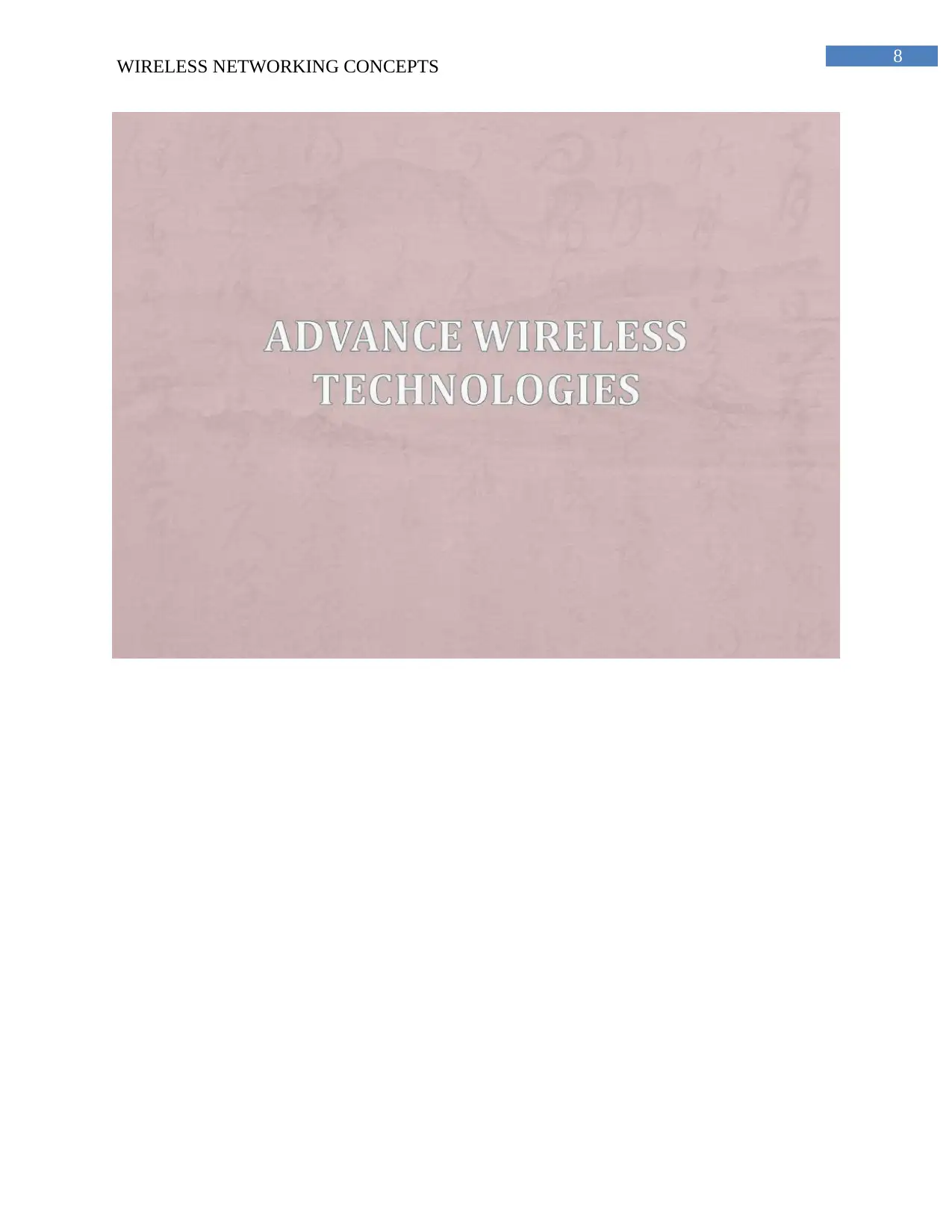
8
WIRELESS NETWORKING CONCEPTS
WIRELESS NETWORKING CONCEPTS
⊘ This is a preview!⊘
Do you want full access?
Subscribe today to unlock all pages.

Trusted by 1+ million students worldwide
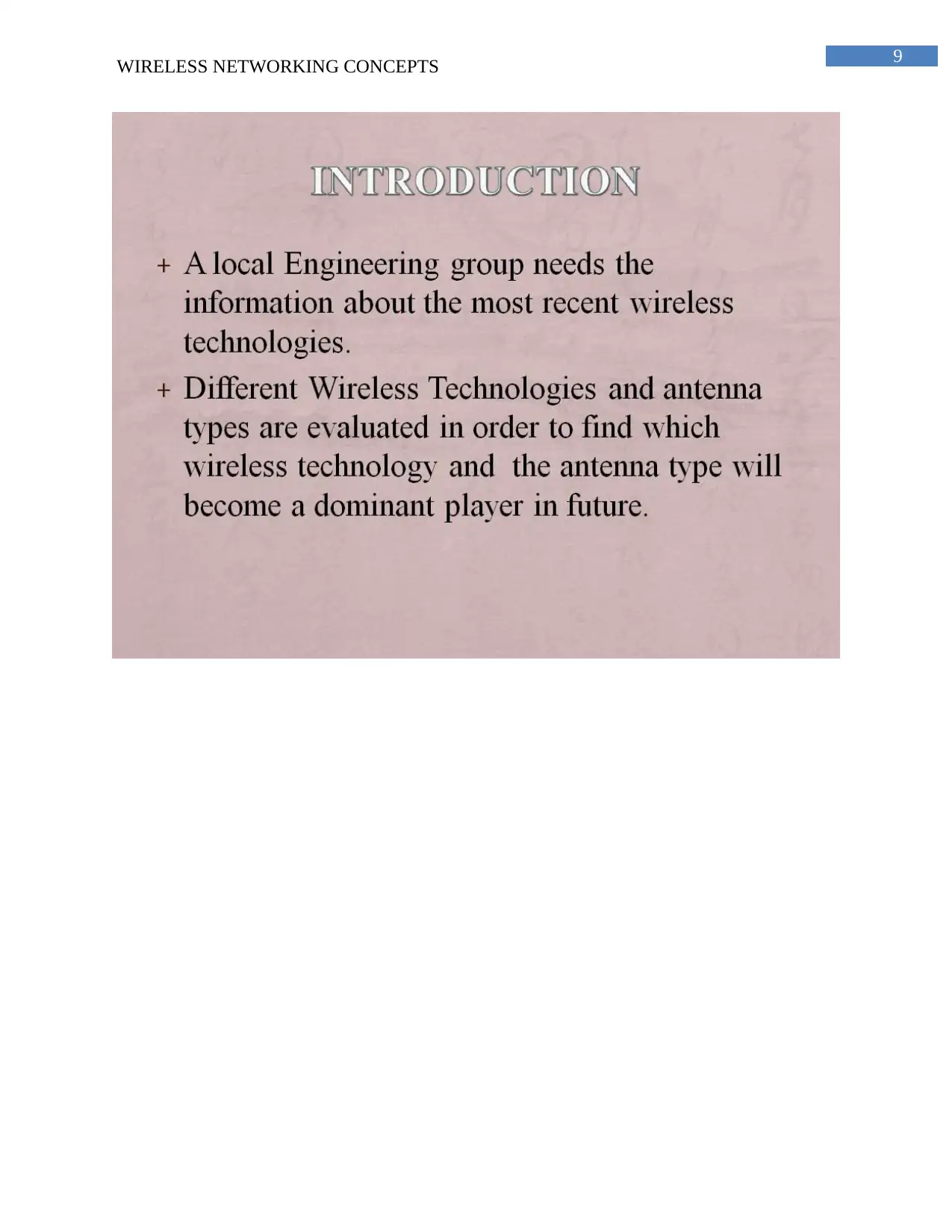
9
WIRELESS NETWORKING CONCEPTS
WIRELESS NETWORKING CONCEPTS
Paraphrase This Document
Need a fresh take? Get an instant paraphrase of this document with our AI Paraphraser
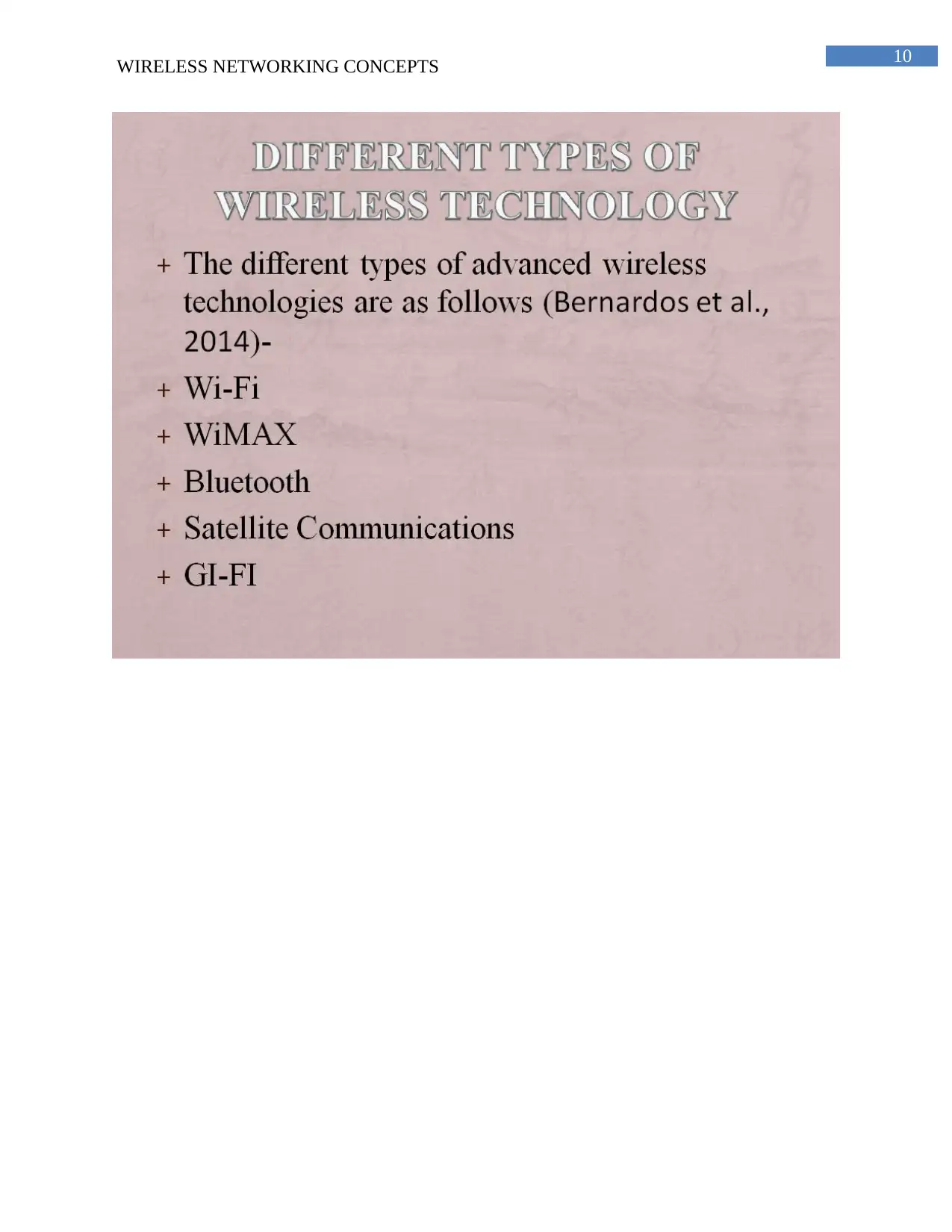
10
WIRELESS NETWORKING CONCEPTS
WIRELESS NETWORKING CONCEPTS
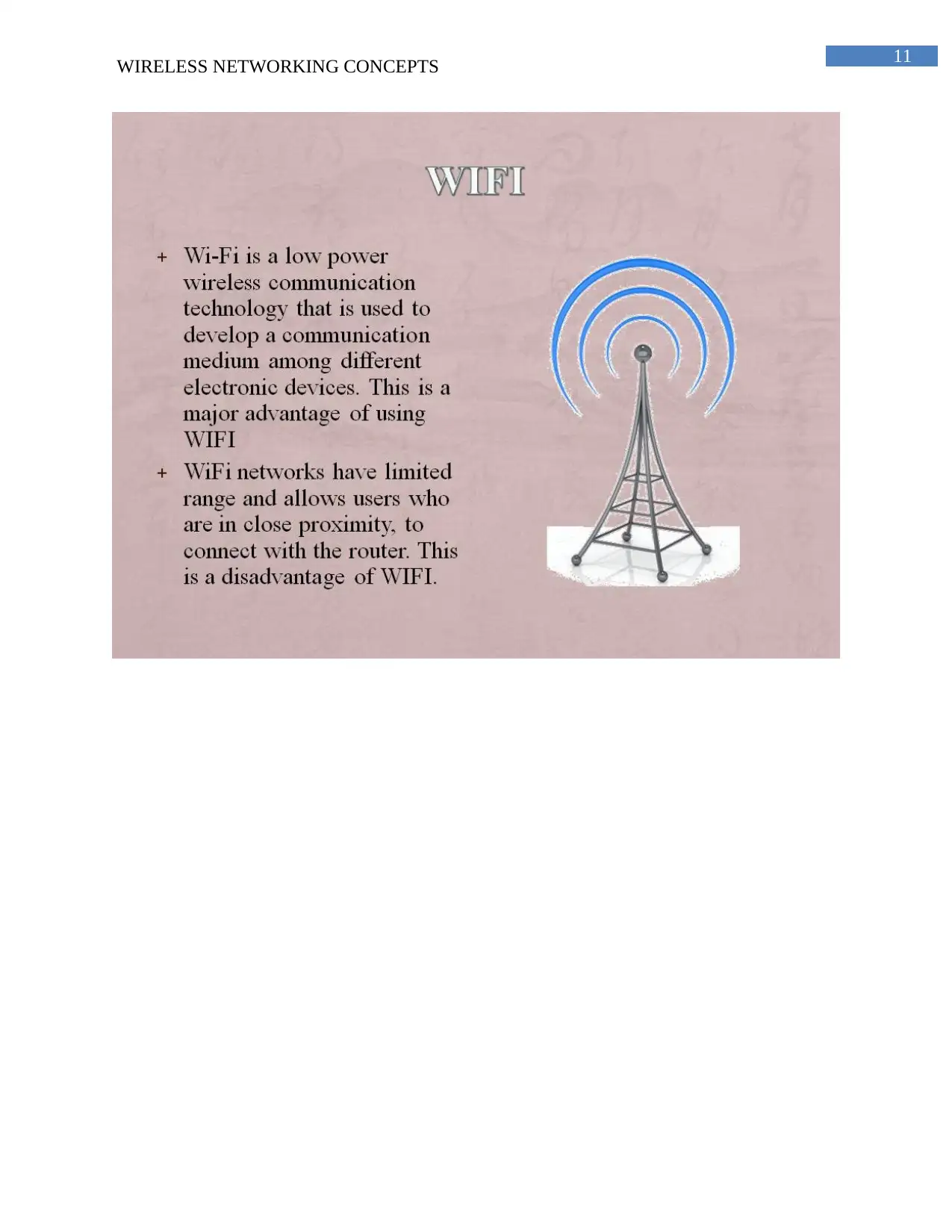
11
WIRELESS NETWORKING CONCEPTS
WIRELESS NETWORKING CONCEPTS
⊘ This is a preview!⊘
Do you want full access?
Subscribe today to unlock all pages.

Trusted by 1+ million students worldwide
1 out of 23
Related Documents
Your All-in-One AI-Powered Toolkit for Academic Success.
+13062052269
info@desklib.com
Available 24*7 on WhatsApp / Email
![[object Object]](/_next/static/media/star-bottom.7253800d.svg)
Unlock your academic potential
Copyright © 2020–2025 A2Z Services. All Rights Reserved. Developed and managed by ZUCOL.



